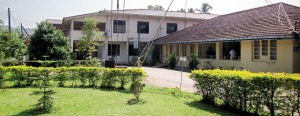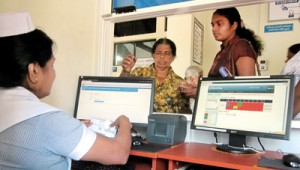12 eHealth pilot projects running in SL – HISSL President
There are presently 12 eHealth pilot projects running in Sri Lanka, according to Prof. Vajira Dissanayake, President of the Health Informatics Society of Sri Lanka (read his column on one such programme, the eIMMR initiative, adjoining this article). Following these successful pilot programmes, many of these eHealth initiatives could go on to change the face of Sri Lanka’s national health service, if implemented, while others are likely to positively impact the day-to-day quality of care at small and medium hospitals island-wide.

Dompe hospital where the first eHospital project came online
Further, he outlined that, broadly, these programmes include the following: systems built around patients, such as patient records; public health, where data is gathered for different types of indicators such as immunisations and maternal and child health records; information collected on various types of control programmes, like STDs, TB, Dengue and Malaria, TB, cancer prevention, etc.; data collected on mortality and morbidity (management); lot of interest on radiology; a huge amount of systems for administration and facilities management; campaigns for non-communicable diseases (NCDs); and even a number of health education programmes.
Four of the ongoing or soon-to-be-kicked-off eHealth pilot projects are as follows:
1. The national Personal Health Number initiative. Currently ongoing, this programme facilitates the assignment of a Personal Health Number to all persons utilising public health services locally, no matter the age, nationality, etc. This number will initially start off being issued by individual public health institutes, with each of these 1,200 organisations having its own “point of issue” prefix added to the six-digit unique patient number. These numbers will enable patient records to be stored in central VPN cloud and accessed by all authorised public health institutes, with plans to loop in even private sector healthcare providers, etc at a later date.

Dompe’s new patient queue management system in action
The pilot project of this initiative, which also features the issuing of cards with the Patient Health Number, is expected to begin by year’s end in five hospitals in the Galle district, according to Dr. Clive James, the Medical Officer for Health Informatics, Health Information Unit, Ministry of Health.
2. Tying in with the Personal Health Number, another programme that has already been running for over two and a half years (one and a half years for development, eight months for testing, and the rest of the period for implementation) has been the electronic Hospital Information Management System (HIMS), a system to collect patient information as well as a decision support system that was developed at the National Cancer Institute in Maharagama by the Ministry of Health, with the aid of the University of Kelaniya. While previously this type of software was developed by IT developers, this time the system was conceptualised and developed by doctors qualified in biomedical informatics, so the information captured is more relevant to decision making.

New patient registration system in Dompe
According to Dr. Nishan Siriwardena, who oversees this programme out of the National Cancer Institute in Maharagama, this project initially started implementing at the Gampola Base Hospital, then deployed at the Maharagama Cancer Hospital, the Teaching Hospital in Peradeniya and Castle Street Hospital. They also started testing this system recently at the teaching hospital in Kurunegala and will likely start deploying there next month.
He also added that the ultimate goal of this programme is to link up the entire hospital network setup into one health cloud, so that hospitals would be able to share essential data, getting important information on time, saving money on duplicate tests, etc.
3. Another eHealth pilot project with nation-wide significance is the initiative on recording and reporting related to the National Programme for Tuberculosis Control and Chest Diseases (NPTCCD). The NPTCCD is the main governmental organisation responsible for tuberculosis and chest diseases control activities in Sri Lanka and the activities include management of the national TB programme and also tracking and management of individual patients with TB and other respiratory diseases. These activities are carried out through the network of 26 district chest clinics, supported by branch clinics and microscopy centres under each district chest clinic, according to Dr. Pramil Liyanage, the programme’s coordinator.
He also added that aggregated reporting, disease surveillance and notification, patient tracking, clinical decision supporting, laboratory and drug management modules were identified as essential components of the information system, thus multi-modular approach had been taken. Further, the aggregated reporting part is already completed and is being successfully implemented at all 26 districts. Electronic Asthma and COPD Clinic Registry functions were also being developed, with future goals including horizontal integration with other healthcare institutions to facilitate information exchange.
4. The final project outlined is the eHospital Dompe pilot project, which was a grassroots project overhauling the health information systems at a small hospital in Dompe and linking it with the larger Gampaha hospital. It covered the entire patient care service offering workflows inclusive of patient registration, electronic queue management system, medical consultation and diagnosis (based on electronic health records), prescribing and issuing of medical drugs, requesting and reporting medical laboratory examinations, medical clinics and other connected auxiliary caring services, according Dr. Sampath Kulathilaka, the Medical Officer in-charge of eHospital Dompe project.
Further, he also noted that, following the success of the project in Dompe; two similar eHospital projects had been implemented, while three additional projects were currently progressing in Gampaha, Horana and Homagama, under the purview of the Western Province Health Department and the ICT Agency of Sri Lanka. As was the case in Dompe, all the smaller hospitals would also be connected to larger, regional hospitals since patients were often referred these for more complicated treatments.
Technology
that benefits
ordinary Sri Lankans
Dear Readers,
Compiled by the Business Times’ Specialist Technology writer Jagdish Hathiramani (email:mobileoption@gmail.com), the main objective of this section is to provide the Sri Lankan public information on
technological advances that would be
useful to them in day-to-day life. With the aim of”Capturing the essence of technological advances for the betterment of Sri Lankan society”, our new Tech/Know page is a public service and, as such, we invite you, the reader, to email us at bt@sundaytimes.wnl.lk with any news or ideas that you
believe merit
publication.
- Business Editor


